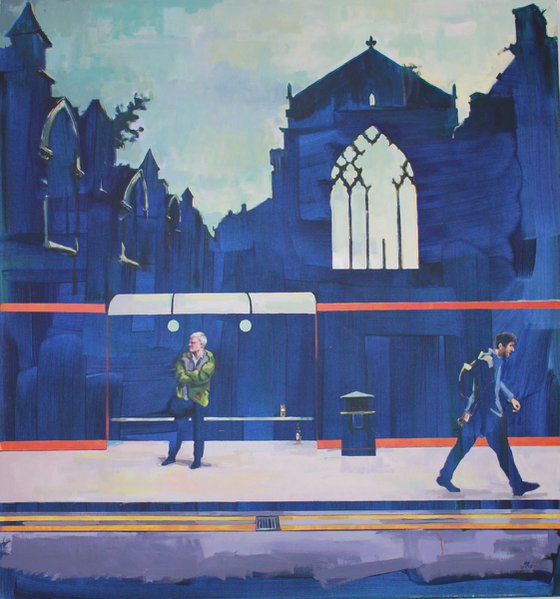- By medium
- By subject
- By budget
- Sales
- Gift cards
- Discover all art
- Artists
- Editors’ picks
- Ideas
Original artwork description:
In “Mill Road Departure I” there is a man standing at a bus stop who was passed by a person walking with a rucksack. There is evidence of the people who occupy this space with the discarded can of notoriously strong lager and a bottle baring the “Bass Charington” geometrically flat red triangle. These functions as a reference to a sometimes invisible community of homeless people.
The figures and bus stop are accurate and authentic of a scene in Cambridge as is the narrative well know locally of this spot being regularly frequented by the homeless. As such it can be seen as a juncture between three separate communities in Cambridge that seem to co-exist but regard each other little.
I walked through this site for a couple of years and so the experience has been amalgamated with some of the art references that are personal to me such as;
a Victor Pasmore sky, The Hanging Gardens of Hammersmith, the building work behind the blue and orange hoarding is replaced with the silhouette of Louis Dageurre’s Ruins of Holyrood Chapel 1824, which was remembered from my first notable visit to the Walker Art Gallery, Liverpool. There is a romantic element here not only for the nostalgia of Dageurre featuring in my art education as a pioneer of photography but also of tapping into wider romanticism of the victorian age such as Bram Stoker's Dracula approaching Whitby and the sense of displacement or alienation or threat this heralds.
Authentic to the Cambridge scene were the lights and larger can present in the bus stop/shelter, These lights and Bass Charrington symbol resonate from Manet’s Bar at the Follies Bergieres (this was the first painting that I recall that seemed to challenge or accuse me in some way) which has a duality of ennui and accusation in the narrative which for me is echoed in the real scene at the Mill Road Bus stop. This was the tangible point of contact between myself (latent) Cambridge (correspondence) and the painting outcome (departure) a structure that informs all works in this series
The flatness of the composition was directly referenced to “Peter getting out of Nick's Pool” by David Hockney which won the John Moores Liverpool Exhibition 6 at the Walker Art Gallery, Liverpool 1967, as well as the double yellow lines for me a motif but resonant of the Boyle family casts of the 1970s linked to authenticity a contentious idea when considering translation of word or image.
Materials used:
Acrylic
Tags:
#contemporary #painting #art #narrativeFeatured by our Editors:
Mill Road, Departure I (2017) Acrylic painting
by Neil Horsefield
£6,000
- Acrylic painting on Canvas
- One of a kind artwork
- Size: 140 x 150 x 4cm (unframed) / 150 x 140cm (actual image size)
- Ready to hang
- Signed on the front
- Style: Impressionistic
- Subject: People and portraits
Loading
Original artwork description
In “Mill Road Departure I” there is a man standing at a bus stop who was passed by a person walking with a rucksack. There is evidence of the people who occupy this space with the discarded can of notoriously strong lager and a bottle baring the “Bass Charington” geometrically flat red triangle. These functions as a reference to a sometimes invisible community of homeless people.
The figures and bus stop are accurate and authentic of a scene in Cambridge as is the narrative well know locally of this spot being regularly frequented by the homeless. As such it can be seen as a juncture between three separate communities in Cambridge that seem to co-exist but regard each other little.
I walked through this site for a couple of years and so the experience has been amalgamated with some of the art references that are personal to me such as;
a Victor Pasmore sky, The Hanging Gardens of Hammersmith, the building work behind the blue and orange hoarding is replaced with the silhouette of Louis Dageurre’s Ruins of Holyrood Chapel 1824, which was remembered from my first notable visit to the Walker Art Gallery, Liverpool. There is a romantic element here not only for the nostalgia of Dageurre featuring in my art education as a pioneer of photography but also of tapping into wider romanticism of the victorian age such as Bram Stoker's Dracula approaching Whitby and the sense of displacement or alienation or threat this heralds.
Authentic to the Cambridge scene were the lights and larger can present in the bus stop/shelter, These lights and Bass Charrington symbol resonate from Manet’s Bar at the Follies Bergieres (this was the first painting that I recall that seemed to challenge or accuse me in some way) which has a duality of ennui and accusation in the narrative which for me is echoed in the real scene at the Mill Road Bus stop. This was the tangible point of contact between myself (latent) Cambridge (correspondence) and the painting outcome (departure) a structure that informs all works in this series
The flatness of the composition was directly referenced to “Peter getting out of Nick's Pool” by David Hockney which won the John Moores Liverpool Exhibition 6 at the Walker Art Gallery, Liverpool 1967, as well as the double yellow lines for me a motif but resonant of the Boyle family casts of the 1970s linked to authenticity a contentious idea when considering translation of word or image.
Materials used:
Acrylic
Tags:
#contemporary #painting #art #narrativeFeatured by our Editors:
14 day money back guaranteeLearn more


